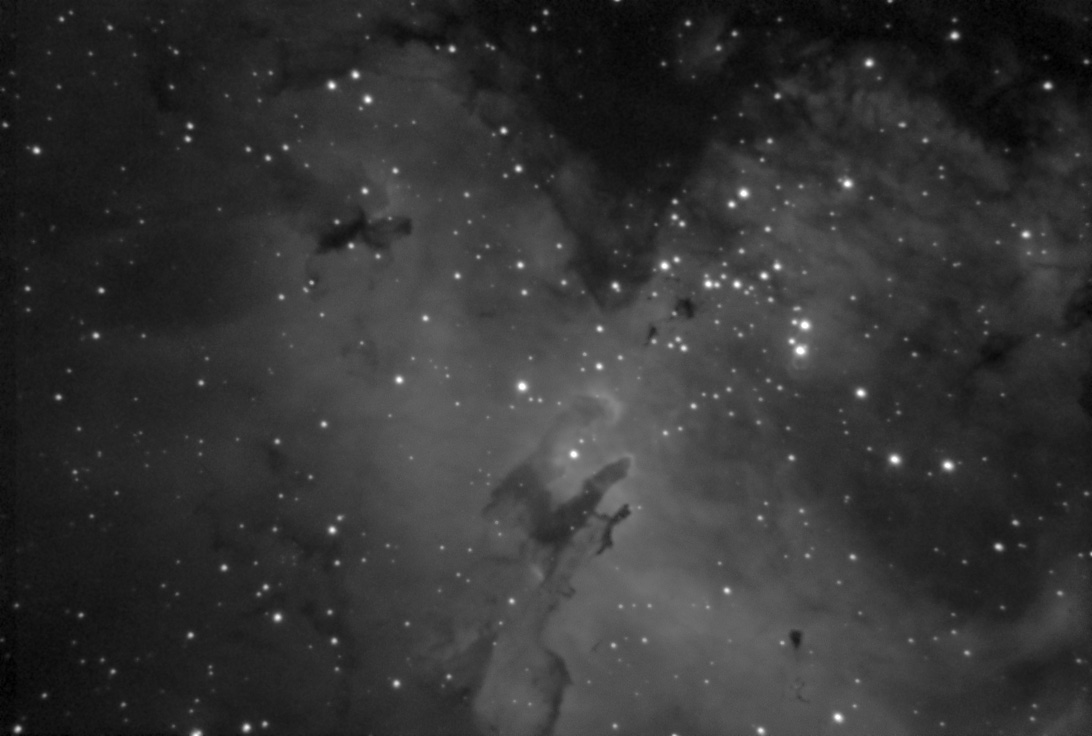M16 - Eagle Nebula ([OIII])

M16 - Eagle Nebula ([OIII]): The Eagle Nebula, which includes the "Pillars of Creation" are imaged here in [O-III], a close pair of "cyan" emission lines (near 500 nm) of doubly ionized Oxygen. In star forming regions, gravity pulls together clumps from the cloud of gas that collapse and form the stars. The first stars that form are the massive, bright blue stars near the center of the cluster. These emit lots of ultraviolet light that then excites the gas in the surrounding clouds. The intense radiation from these same stars is also "blowing away" the clouds - in direct competition with gravity. These competing forces give the "melting candle wax" appearance of parts of this nebula.
Messier: 16
NGC: 6611
Right Ascension: 18h 18.8m
Declination: -13° 47'
Apparent Magnitude: 6.4
Date: August 2010
Equipment:
Telescope: Meade 16" Schmidt Cassegrain
Camera: SBIG ST-10XE
Guiding: AO-8
6nm Astrodon [OIII] filter
Exposure: 9x10 minutes binned 2x2
The camera was at -35°C
Processing Notes: Data acquisition with CCDSoft. Reduced and aligned in CCDStack. Subs combined in Sigma Beta. Arcsine stretch import into Photoshop. Adjusted curves and levels. Slight blur on the dim areas and sharpening on non-star bright areas. A highpass filter of the non-star regions was overlayed to increase contrast. Slight minimum filter on the brighter stars.
Scale: 1.05"/pixel
Links to images of this object on other sites:
http://apod.nasa.gov/apod/ap080719.html
http://www.astrocruise.com/milky_way/M16_02.htm
http://www.narrowbandimaging.com/images/m16_mk1sn2_dm_geg_cs4_ha_12x10min_svga.jpg
Additional Comments: The 2010 H-alpha image of M16 from the Fort Lewis observatory is found here: http://www.fortlewis.edu/observatory/image_detail.asp?ID=212
Numerous other Eagle Nebula images can be found by searching this site for M16.
The pair of emission lines at 495.9 and 500.7 nm were first observed in the spectra of planetary nebulae in the 1860's. Since the line was not immediately recognized, it was thought to belong to a new element. There are a couple of simple reasons that the lines are not typically found in terrestrial environments, and had not been seen before that time. First, the lines occur in oxygen that has had two electrons removed (via collisions or ionizing radiation). Second, the quantum states that produce the lines are "metastable", which means that the average time to decay to a lower energy state (in this case the ground state) is quite long compared to the time between collisions with nearby particles (other oxygen atoms or ions). If the ion undergoes a collision, no radiation will occur, so no cyan line will be observed. In interstellar space, the density is so low, that the ions are actually more likely to radiate than to undergo a collision, which is fortunate for us, because we get to see them then. http://en.wikipedia.org/wiki/Doubly_ionized_oxygen
Views: 3439
 This work is licensed under a Creative Commons Attribution-NonCommercial-ShareAlike 4.0 International License.
This work is licensed under a Creative Commons Attribution-NonCommercial-ShareAlike 4.0 International License.

